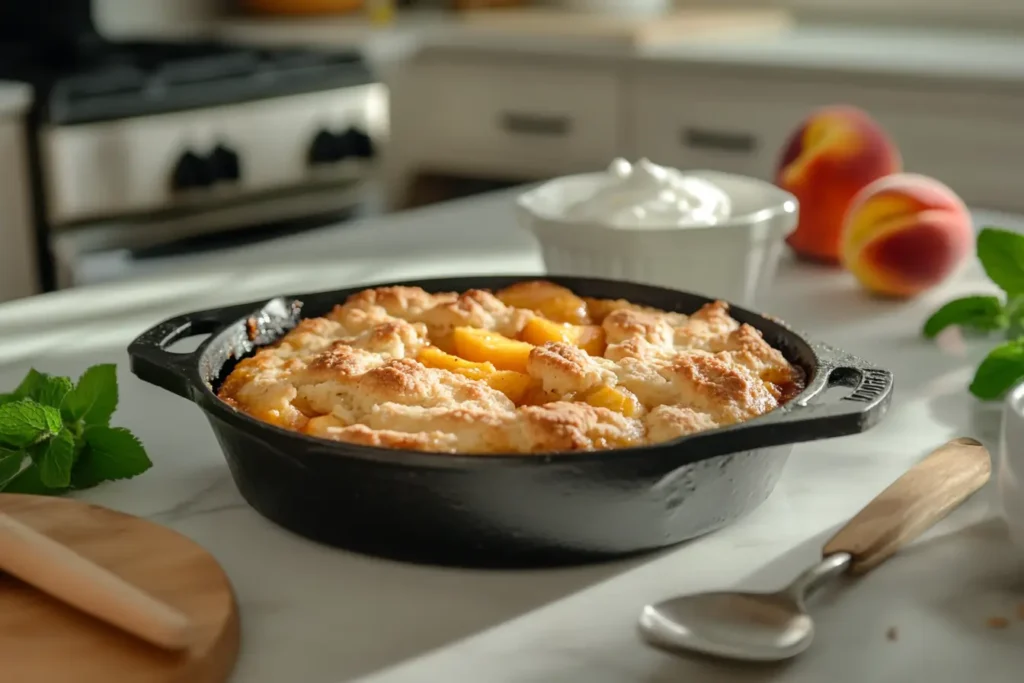Why Is It Called Peach Cobbler? Much like frozen burrito tips guide you to the perfect quick meal, this question arises when enjoying this delicious, rustic dessert. The name “cobbler” refers to its unique, uneven crust, which resembles a cobbled stone street. In this article, we’ll dive into the fascinating history, origins, and traditions behind peach cobbler, exploring why it remains a beloved dessert around the world.
Table of Contents
The Origin of the Name “Peach Cobbler”
Historical Context
Colonial America saw the origins of peach cobbler, as European settlers recreated familiar desserts despite limited resources. Traditional pies needed proper ovens and rolled crusts, which weren’t practical on the frontier. Settlers layered fruits like peaches with dollops of biscuit dough or batter and cooked them over open fires.
The name “cobbler” likely comes from the dessert’s rustic, uneven appearance. Unlike the smooth, even crust of a pie, the biscuit topping baked unevenly and resembled the cobblestone streets common in Europe at the time. This charmingly rough texture became the signature look of cobblers, much like frozen burrito tips ensure the perfect texture for quick meals.
The “Cobbled” Topping
The distinctive topping defines a cobbler and gives the dessert its name. Bakers spoon or drop the topping over the fruit filling, creating a patchy, “cobbled” appearance. The topping bakes to a golden color, becoming slightly crisp on the outside while staying soft and tender inside.
This irregularity is both practical and delightful—it reflects the resourcefulness of early cooks who made do with what they had, and it gives the dessert a charming, homemade feel. Why do people call it peach cobbler? The name comes from the “cobbled-together” look of its biscuit or batter topping.
With its humble beginnings and unique aesthetic, peach cobbler became a creative solution for dessert lovers of the past. In the next section, we’ll dive into how this dish evolved in America and why it became synonymous with Southern hospitality.
For creative ideas on blending fruits in desserts, check out Rotisserie Chicken.
The History of Peach Cobbler in America

Southern Roots and Cultural Significance
Peach cobbler flourished in the Southern United States, where peaches symbolize regional pride. In the 19th century, peaches became a staple crop in the South, especially in Georgia, now known as the “Peach State.” The abundance of fresh peaches made cobbler a practical dessert, allowing home cooks to use readily available and often overripe fruit.
The simplicity of the dessert contributed significantly to its cultural importance. Early Southern cooks valued cobbler for its ease of preparation, requiring just a few basic ingredients like flour, sugar, butter, and peaches. Its accessibility allowed families across all socioeconomic levels to enjoy it, solidifying its status as a Southern classic.
Evolution Over Time
Over time, peach cobbler evolved from a simple frontier dish into a cherished dessert, just as frozen burrito tips have improved quick meal preparation over the years, often featured at picnics, potlucks, and holiday gatherings. Early recipes often used cast iron skillets and open-fire cooking methods, but modern versions rely on ovens and come with a variety of topping styles, from biscuit dough to cake batter.
One of the biggest changes over time is the addition of spices like cinnamon and nutmeg, which enhance the natural sweetness of the peaches. Some contemporary recipes even incorporate creative ingredients like oats, nuts, or caramel drizzle, adding new layers of flavor and texture.
Despite these innovations, the essence of peach cobbler remains the same—a simple yet satisfying dessert with a rich history. This evolution demonstrates how cobbler has adapted to changing tastes while retaining its rustic charm.
How Peach Cobbler Became a Southern Icon
Peaches: The Southern Symbol
The South has long embraced peaches, not just for their abundance but also for their significance in regional identity. Georgia’s peach industry, which began booming in the late 1800s, helped establish the fruit as a Southern staple. The combination of sweet, juicy peaches and a warm biscuit topping made cobbler the ideal way to showcase this prized fruit.
Peach cobbler’s popularity grew alongside the South’s reputation for hospitality, much like frozen burrito tips have grown in popularity for quick and satisfying meals. It became a dessert that symbolized warmth, generosity, and the joys of sharing food with loved ones. Whether served at family reunions, church gatherings, or backyard barbecues, peach cobbler remains a dish that brings people together.

The Role of Community and Celebration
Beyond its taste and simplicity, peach cobbler holds a special place in Southern traditions. It’s a dessert that’s deeply tied to moments of celebration, from summer festivals to Thanksgiving dinners. In many communities, baking a peach cobbler isn’t just about making dessert—it’s about honoring the past and preserving culinary heritage.
Why do we call it peach cobbler? The name goes beyond its cobbled topping, capturing a rich cultural story of resourcefulness, community, and the enduring love for peaches in Southern life.
In the next section, we’ll explore how this iconic dessert has inspired variations around the world while remaining a favorite in American kitchens.
Variations of Peach Cobbler Around the World
International Adaptations
While peach cobbler is deeply embedded in American culinary tradition, similar desserts from around the world put their own unique spin on the idea of fruit paired with a baked topping. In Britain, for instance, you’ll find crumbles that use a streusel-like topping, while in France, clafoutis layers fruit with a baked custard-like batter. Both resemble cobblers in their rustic appeal but differ in texture and preparation methods.
In other regions, tropical fruits like mango or pineapple are substituted for peaches, resulting in cobbler-inspired dishes with bold, exotic flavors. These adaptations highlight the dessert’s versatility and universal appeal, similar to how frozen burrito tips cater to diverse tastes and preferences..
Regional Twists in the U.S.
Across the United States, peach cobbler takes on many forms depending on local preferences and available ingredients:
- Deep South: The classic version uses ripe peaches, a buttery biscuit topping, and a hint of cinnamon or nutmeg.
- Western Variations: Often incorporate oats or nuts into the topping for added crunch.
- Northeast Favorites: Feature combinations like peach and blueberry cobbler, showcasing the region’s seasonal fruits.
Frequently Asked Questions
Why Is It Called a Cobbler?
The name “cobbler” comes from its cobbled-together appearance. Unlike a smooth pie crust, the biscuit or batter topping bakes unevenly, creating a rough texture reminiscent of cobblestones. This charming imperfection is what sets cobbler apart from other desserts.
Who Invented Peach Cobbler, and What Can Frozen Burrito Tips Teach Us?
While no single person can claim credit for inventing peach cobbler, its origins lie in colonial America. Settlers, lacking access to ovens or pastry-making tools, improvised by baking fruits with a simple topping over an open fire. This practical innovation eventually evolved into the dessert we know and love today.
What Makes Peach Cobbler Different From Pie?
Peach cobbler is distinct from pie due to its lack of a bottom crust. Pies typically enclose the filling in a flaky pastry, while cobblers feature a topping-only design, allowing the fruit juices to mingle with the biscuit or batter as it bakes. This difference gives cobbler a more casual and homey feel compared to the structured elegance of pie.
Modern Takes on Peach Cobbler
Reinventing the Classic Recipe
While the traditional peach cobbler remains a beloved dessert, modern takes have introduced new flavors and textures to this timeless dish. Bakers today experiment with creative ingredients to bring fresh twists to the table:
- Topping Variations: Swapping the biscuit topping for a cake batter or puff pastry creates a unique spin.
- Flavor Enhancements: Adding caramel drizzle, a splash of bourbon, or a pinch of cardamom elevates the dessert.
- Diet-Friendly Options: Gluten-free flours or vegan butter can easily adapt peach cobbler for specific dietary needs.
These reinventions prove that cobbler can remain relevant and exciting without losing its rustic charm, just as frozen burrito tips offer new ways to enhance convenience meals. But even with these changes, its cobbled topping still answers the question, why is it called peach cobbler?
Incorporating Seasonal Fruits
While peaches are the star of this dessert, seasonal fruits can add variety throughout the year. For example:
- In summer, fresh berries or cherries pair beautifully with peaches.
- Fall calls for heartier combinations like apples, pears, or cranberries.
- Winter brings the opportunity to use preserved fruits or frozen peaches, ensuring cobbler is accessible year-round.
Experimenting with seasonal ingredients keeps the tradition of cobbler alive while showcasing the best produce each time of year.
The Timeless Appeal of Peach Cobbler
Why It’s a Dessert for All Generations
Why is it called peach cobbler? More than a dessert, it’s a connection to the past. Its simplicity and homemade feel make it a dish that resonates across generations. Grandparents pass down their recipes, and younger generations put their own spin on it, much like frozen burrito tips evolve with modern cooking methods, creating a dessert that feels both nostalgic and new.
When people ask, “Why is it called peach cobbler?” the answer isn’t just about the topping. It’s also about the memories tied to sharing a dish that has brought families together for centuries.
Celebrating Peach Cobbler’s Legacy
This iconic dessert is celebrated not only for its delightful flavor but also for its cultural significance. Featured at Southern festivals and family gatherings, this sweet treat symbolizes community, creativity, and comfort. Its enduring popularity reflects its versatility and universal charm.
Whether served warm with a scoop of ice cream or enjoyed straight from the baking dish, peach cobbler continues to delight dessert lovers everywhere.
The Cultural Significance of Peach Cobbler
Peach Cobbler in Southern Traditions
Peach cobbler holds a special place in Southern culture, symbolizing comfort, community, and the joy of shared meals. The dessert’s humble origins and its association with peaches—a signature Southern crop—have made it a staple at gatherings such as barbecues, church socials, and family reunions. Its presence on the table often signifies celebration and togetherness.
But why is it called peach cobbler? The name not only reflects its cobbled appearance but also highlights the ingenuity of early cooks who created a dessert that could easily feed a crowd with simple ingredients. This practicality and charm continue to make cobbler a favorite choice for hosting and entertaining.
A Star at Festivals and Competitions
Across the South, peach cobbler is celebrated at festivals and food competitions, showcasing its enduring popularity. Events like the Georgia Peach Festival often include cobbler contests, where bakers compete to create the most delicious and inventive versions of this iconic dessert.
These events honor the rich history and tradition of peach cobbler while inspiring new generations of bakers to carry on its legacy. Whether traditional or modern, every variation pays homage to the dessert’s cultural roots and its role in bringing people together.
Why Peach Cobbler Will Always Be a Favorite
A Recipe That Stands the Test of Time
The appeal of peach cobbler lies in its simplicity and adaptability. Unlike many desserts that require precision and advanced techniques, cobbler is forgiving and versatile. Its ingredients can be adjusted to suit individual tastes or dietary needs, ensuring that it remains relevant in today’s kitchens.
Even as food trends evolve, peach cobbler continues to charm with its rustic look and heartwarming flavor. It’s no wonder that people still ask, “Why is it called peach cobbler?”—its name and reputation endure because of its timeless qualities.
Inspiring Future Generations
Peach cobbler is more than just a dessert—it’s a tradition that connects generations. As families share recipes and create new memories, cobbler stands as a testament to the creativity and resourcefulness of the cooks who first crafted it.
If you’re feeling inspired to create your own version of this iconic dish, check out Julia Recipes for ideas that blend tradition with a modern twist.Whether you choose the classic recipe or experiment with something new, peach cobbler’s legacy is sure to remain a cherished favorite at any table.



